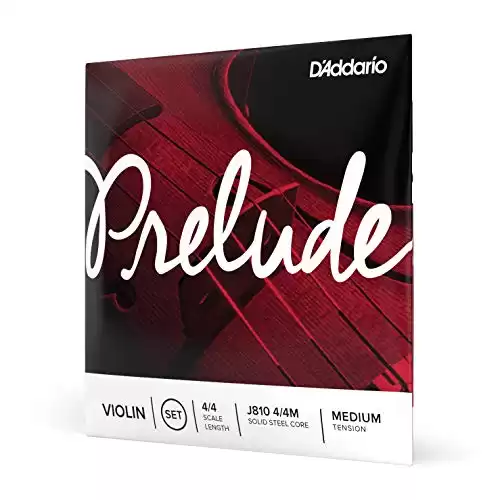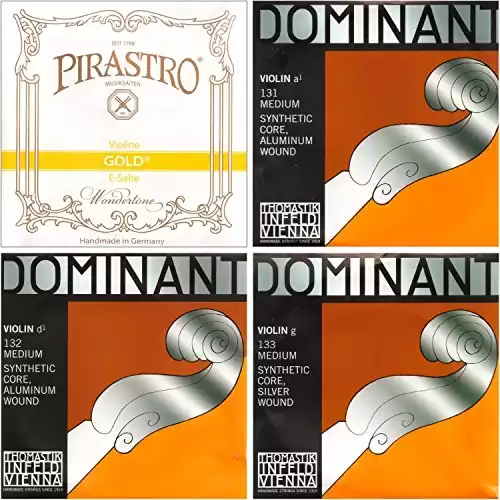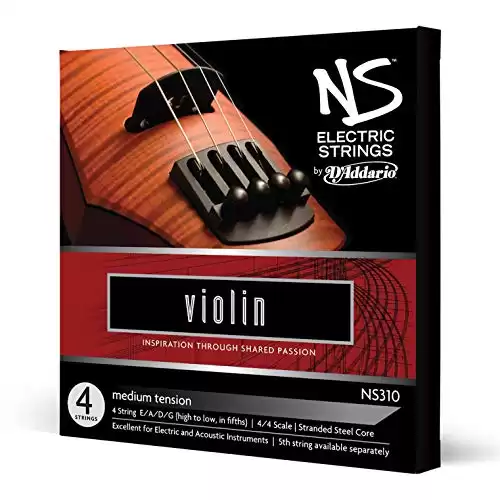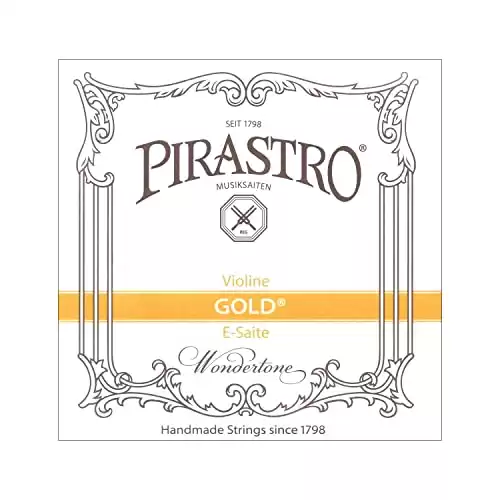 The violin strings make a huge difference.
The violin strings make a huge difference.
After the violin itself, nothing else has a larger impact on the sound your bow produces.
That’s why it is important to get the best violin strings possible.
The problem is that the best string for me is not the best string for you.
It is very much an individual thing and depends on your playing style and the type of sound you prefer.
To help you choose the right violin string for you, we’ve listed several different options below.
Keep reading for a rundown of the top violin strings available in terms of value for money, and for help in choosing the right ones for you.
Table of Contents
- 1 Best Violin Strings Compared
- 2 Best Strings For The Violin Reviewed
- 2.1 Best Violin Strings For Beginners: D’Addario Prelude Violin String Set
- 2.2 Best Violin Strings For Intermediate Player: JSI Special Gold Label Strings
- 2.3 Best Violin Strings For Professionals: Pirastro Evah Pirazzi Gold Violin String Set
- 2.4 Best Violin Strings For Warm Sound: Pirastro Evah Pirazzi Set
- 2.5 Best Electric Violin Strings: D’Addario NS310 Electric Violin Strings
- 2.6 Best E-String: Pirastro Gold Label E String
- 3 Violin String Buying Guide
- 4 Best Violin String: Final Thoughts
Best Violin Strings Compared
Best Strings For The Violin Reviewed
All of the strings you saw in the table above are great. It’s just a matter of finding the best set for you. The brief reviews below will help you figure out which ones are right for your style and sound preference.
Best Violin Strings For Beginners: D’Addario Prelude Violin String Set
- Excellent price-quality ratio
- Great for students
- Easy to mount
- They are not expensive
- The strings are tightly packed so that it is impossible to see if there is any damage prior to opening the package
These violin strings are all that beginners need. The package includes a whole set of four strings that are intended for 4/4 violins. The tension is medium and thus perfect for beginners who are still finding their sound.
The fact that they are easy to set up adds another positive point in the “good for beginners” aspect. Of course, beginners should always look for help when mounting and tuning the strings in the beginning, but these make it as easy as possible.
In addition to rehearsals, these strings are also suitable for folk and country music. But you need to tune them well, in order to be able to perform with them on a high level.
Best Violin Strings For Intermediate Player: JSI Special Gold Label Strings
- A perfect balance between warmth and loudness
- A full set compatible with many different violins
- A very good alternative to natural gut strings
- Good price for the quality
- Sometimes they might need time to loosen up until you get that warm sound they possess
Intermediate violinists probably already have more than one violin (practice violin and performance violin). Also, such violinists play often and they need strings that will last.
The JSI medium gauge violin strings everything intermediate players need. They go great with various types of violins, they last quite a long time, and they produce a warm and strong sound.
These strings will do the job for various purposes, both practice and performance, regardless of the style of music you play.
Best Violin Strings For Professionals: Pirastro Evah Pirazzi Gold Violin String Set
- Incredibly versatile
- Pirastro Evah strings always offer an amazing sound
- Good reputation
- Hard to set up
More experienced violin players will know the name. These medium gauge strings are of top quality and will provide everything a violin player needs.
Rich, vibrant, colorful, warm, powerful sound – a player can achieve anything with these strings depending on tuning and playing technique. There are so many possibilities with these strings that they can be used for various styles and performances.
But because of that, the setup process is a bit delicate. Be that as it may, experienced violin players will know what to do, it will just take time.
Best Violin Strings For Warm Sound: Pirastro Evah Pirazzi Set
- Incredibly affordable for this kind of quality
- A full set of high-quality strings
- Warm sound, especially from the E-string
- They might not last for too long (around 4 months)
Just as the previous Pirastro Evah is perfect for professionals, these violin strings also offer the perfect balance between professionalism and price.
To get the warm violin tone that adorns many Stradivarius violins, but at a much lower price, this set is the right solution.
All four strings from the set have an ideal balance of quality and sound in their own way, and although it is a bit difficult to set them up and work them out, the result will definitely be satisfying.
Best Electric Violin Strings: D’Addario NS310 Electric Violin Strings
- Incredibly affordable for this kind of performance
- Nice, warm, clean sound
- Easy to mount and tune
- Treat with care as they are quite delicate
When it comes to electric violins, not all strings will match due to the uniqueness of the instrument. Therefore, it is best to buy strings that are intended for electric violin.
This set is great for electric violins, especially considering the price for which you can get them. The whole set is easy to install and the strings produce a nice, warm sound, very similar to good wooden violins with good strings.
All you need before playing is a little warm-up and in ten minutes, the strings will sound great.
Best E-String: Pirastro Gold Label E String
- Easy to mount and tune
- Great sound
- Will last for a long time
- Inexpensive
- Make sure to order from certified sellers as some will sell unusable strings
E-strings are often a problem for violinists for two reasons: some have a squeaking sound by nature and others snap very quickly. (God forbid a string comes along that does both!)
This e-string from Pirastro costs only $10 and will give you a lot. For a start, it won’t break in the foreseeable future.
Second, it will give you the sound that the e-string should provide. Make sure you buy one with a ball at the end for an easier mount.
Violin String Buying Guide
There are several different kinds of violin strings on the market so how do you make a good choice?
Which strings are right for you will depend on several criteria, mainly the sound and playing comfort you are looking for, the lifespan of the strings, and your budget.
First, let’s take a look at what types of violin strings exist.
Types Of Violin Strings
There are three main different types of strings: those made from animal gut, those made from steel, and those made from a synthetic material.
Gut Strings
Animal gut is the oldest material used to make strings. Gut strings were used by the majority of violinists until the beginning of the 20th century.
They are made with mutton or beef gut, and can be reinforced with aluminum or silver wire. Today they are mainly mounted on the violins of musicians practicing historical research in the field of baroque and classical music.
That said, wound gut strings are suitable for all types of instruments and repertoire, and many violinists use them.
In general, their tension is less than that of steel strings or synthetics. As a result, they are more comfortable to play, because they are more flexible under the fingers.
On the other hand, they are more demanding on your bow technique and movement. They also tend to wear out faster (since gut is a living material) and go out of tune more often. You’ll want to invest in the best violin tuner you can get.
Steel Strings
Steel violin strings were introduced at the beginning of the 20th century, in response to the “defects” of gut strings (see above). They also allow industrial production on a larger scale, while gut strings are more of an artisanal product.
In general, steel strings offer a clear and brilliant sound, tauter but less rich in harmonics than their gut or synthetic cousins. They are more stable in tuning, have a good lifespan, and are generally inexpensive.
Synthetic Strings
Synthetic violin strings are probably the most used strings today, because they attempt to combine the best qualities of gut (warmth and richness of tone, comfort under the fingers) and steel (stability and lifespan).
They were created in the middle of the 20th century by the manufacturer Thomastik in perlon (a kind of extremely resistant nylon) and they very quickly met with great success.
Strengths And Weaknesses
Please note that the rendering is different from one violin to another, depending on its manufacture, its current state, and its settings (placement of the soul, the bar, and the bridge).
Changing steel or synthetic strings for gut strings, in particular, could require a visit to the luthier to adapt the settings of the instrument. On the other hand, the transition from steel strings to synthetic strings does not pose any problem.
Choosing The Right Violin Strings?
Light, medium, or heavy?
These terms refer to the gauge of the strings, and therefore to their tension on the violin.
- Light: a thin string with less tension; the sound is clearer, with a little less volume, but a better response under the bow
- Heavy: a thicker string with stronger tension; a more resonant string, but with a less lively response under the bow
- Medium: a compromise between tension and sound; suitable for any type of playing
The choice really depends on your style of playing. If you “hit” the string a lot with the bow and have a more intense way of playing, strings with high tension (heavy) are better.
If you have a rather light bow and prefer speed and flexibility, choose strings with a lighter tension (light or medium). This is true whether you have the best violin bow for intermediate player or a cheap bow for beginners.
Additional Tips
- After changing your string, be patient! It will take a few days to find its ideal tension and a little more time for optimal sound.
- Always pay attention to the position of your bridge. After changing a string, it often needs to be tuned. This results in increased tension on the bridge towards the fingerboard. If you notice it leaning a little forward, bring it back to a straight position.
- Maintain your strings: wipe the violin rosin with a cloth after each practice.
Best Violin String: Final Thoughts
Which violin string is best for you depends primarily on your playing style and the type of sound you prefer.
Any of the strings listed above are great, so you really can’t go wrong, no matter which you choose. So go ahead and get the one that best matches what you need in terms of sound and style.
Naturally, budget will probably play a role, too. It does for most of us. Luckily, none of the above strings are overly expensive and all are a great value, when compared to any other options that are out there.












Leave a Reply